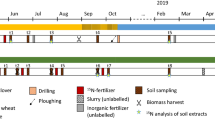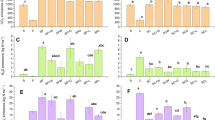Abstract
About 50–60% of dairy cattle slurry nitrogen is ammonium N. Part of the ammonium N in cattle slurry is immobilised due to microbial decomposition of organic matter in the slurry after application to soil. The immobilisation and the remineralisation influence the fertiliser value of slurry N and the amount of organic N that is retained in soil. The immobilisation and the remineralisation of 15 N-labelled dairy cattle slurry NH4-N were studied through three growing seasons after spring application under temperate conditions. Effects of slurry distribution (mixing, layer incorporation, injection, surface-banding) and extra litter straw in the slurry on the plant utilisation of labelled NH4-N from slurry were studied and compared to the utilisation of 15N-labelled mineral fertiliser. The initial immobilisation of slurry N was influenced by the slurry distribution in soil. More N was immobilised when the slurry was mixed with soil. Surface-banding of slurry resulted in significant volatilisation losses and less residual 15N in soil. Much more N was immobilised after slurry incorporation than after mineral fertiliser application. After 2.5 years the recovery of labelled N in soil (0–25 cm) was 46% for slurry mixed with soil, 42% for injected slurry, 22% for surface-banded slurry and 24% for mineral fertiliser N. The total N uptake in a ryegrass cover crop was 5–10 kg N/ha higher in the autumn after spring-application of cattle slurry (100–120 kg NH4-N/ha) compared to the mineral fertiliser N reference, but the immobilised slurry N (labelled N) only contributed little to the extra N uptake in the autumn. Even in the second autumn after slurry application there was an extra N uptake in the cover crop (0–10 kg N/ha). The residual effect of the cattle slurry on spring barley N uptake was insignificant in the year after slurry application (equivalent to 3% of total slurry N). Eighteen months after application, 13% of the residual 15N in soil was found in microbial biomass whether it derived from slurry or mineral fertiliser, but the remineralisation rate (% crop removal of residual 15N) was higher for fertiliser- than for slurry-derived N, except after surface-banding. Extra litter straw in the slurry had a negligible influence on the residual N effects in the year after application.
It is concluded that a significant part of the organic N retained in soil after cattle slurry application is derived from immobilised ammonium N, but already a few months after application immobilised N is stabilised and only slowly released. The immobilised N has negligible influence on the residual N effect of cattle slurry in the first years after slurry application, and mainly contributes to the long-term accumulation of organic N in soil together with part of the organic slurry N. Under humid temperate conditions the residual N effects of the manure can only be optimally utilised when soil is also covered by plants in the autumn, because a significant part of the residual N is released in the autumn, and there is a higher risk of N leaching losses on soils that receive cattle slurry regularly compared to soils receiving only mineral N fertilisers.
Similar content being viewed by others
References
Balabane M and Balesdent J 1995 Medium-term transformations of organic N in a cultivated soil. Eu. J. Soil Sci. 46, 497–505.
Beauchamp E G 1987 Corn response to residual N from urea and manures applied in previous years. Can. J. Soil Sci. 67, 931–942.
Brookes P C, Kragt J F, Powlson, D S and Jenkinson D S 1985 Chloroform fumigation and the release of soil nitrogen: The effects of fumigation time and temperature. Soil Biol. Biochem. 17, 831–835.
Dosch P and Gutser R 1996 Reducing N losses (NH3, N2O, N2) and immobilization from slurry through optimized application techniques. Fert. Res. 43, 165–171.
Glendining M J, Poulton P R, Powlson D, Macdonald A J and Jenkinson D S 2001 Availability of the residual nitrogen from a single application of 15N-labelled fertiliser to subsequent crops in a long-term continuous barley experiment. Plant Soil 233, 231–239.
Hart P B S, Powlson D S, Poulton P R, Johnston A E and Jenkinson D S 1993 The availability of the nitrogen in the crop residues of winter wheat to subsequent crops. J. Agric. Sci. (Camb), 121, 355–362.
Heidmann T, Nielsen J, Olesen S E, Christensen B T and Østergaard H S 2001 Ændringer i indhold af kulstof og kvælstof i dyrket jord: Resultater fra Kvadratnettet 1987–1998. DIAS Report Plant Production 54, 1–73.
Jensen B, Sørensen P, Thomsen I K, Jensen E S and Christensen B T 1999 Availability of nitrogen in 15N-labeled ruminant manure components to successively grown crops. Soil Sci. Soc. Am. J. 63, 416–426.
Jensen E S 1991 Evaluation of automated analysis of 15N and total N in plant material and soil. Plant Soil 133, 83–92.
Jensen L S, Pedersen I S, Hansen T B and Nielsen N E 2000 Turnover and fate of 15N-labelled cattle slurry ammonium N applied in the autumn to winter wheat. Eu. J. Agron. 12, 23–35.
Joshi J R, Moncrief J F, Swan J B and Burford P M 1994 Long-term conservation tillage and liquid dairy manure effects on corn. I. Nitrogen availability. Soil Till. Res. 31, 211–224.
Joergensen R G and Mueller T 1996 The fumigation extraction method to estimate soil microbial biomass: Calibration of the kEN value. Soil Biol. Biochem. 28, 33–37.
Kirchmann H and Lundvall A 1993 Relationship between N immobilization and volatile fatty acids in soil after application of pig and cattle slurry. Biol. Fert. Soils 15, 161–164.
Klausner S D, Kanneganti V R and Bouldin D R 1994 An approach for estimating a decay series for organic nitrogen in animal manure. Agron. J. 86, 897–903.
Larsen K E, Petersen J, Hansen J F and Sommer S G 1992 Nitrogen effect of raw and fermented slurry after surface spreading and direct injection (in Danish, with English abstract). Tidskrift for Planteavl 96, 223–243.
Macdonald A J, Poulton P R, Stockdale E A, Powlson D S and Jenkinson D S 2002 The fate of residual 15N-labelled fertiliser in arable soils: its availability to subsequent crops and retention in soil. Plant Soil 246, 123–137.
Mary B, Recous S, Darwis D and Robin D 1996 Interactions between decomposition of plant residues and nitrogen cycling in soil. Plant Soil 181, 71–82.
SAS 1989 SAS/STAT User’s Guide, Version 6, Fourth Edition, Vol. 2. SAS Institute Inc. Cary, North Carolina.
Schröder J J and Van Keulen H 1997 Modelling the residual N effect of slurry applied to maize land on dairy farms in The Netherlands. Neth. J. Agric. Sci. 45, 477–494.
Sulce S, Palma-Lopez D, Jaquin F, Vong P C and Guiraud G 1996 Study of immobilization and remobilization of nitrogen fertiliser in cultivated soils by hydrolytic fractionation. Eu. J. Soil Sci. 47, 249–255.
Sørensen P 1998 Effects of storage time and straw content of cattle slurry on the mineralization of nitrogen and carbon in soil. Biol. Fertil. Soils 27, 85–91.
Sørensen P and Amato M 2002 Remineralization and residual effects of N after application of pig slurry to soil. Eu. J. Agron. 16, 81–95.
Sørensen P and Jensen E S 1991 Sequential diffusion of ammonium and nitrate from soil extracts to a polytetrafluoroethylene trap for 15N determination. Anal. Chim. Acta 252, 201–203.
Sørensen P and Jensen E S 1995 Mineralization-immobilization and plant uptake of nitrogen as influenced by the spatial distribution of cattle slurry in soils of different texture. Plant Soil 173, 283–291.
Sørensen P, Jensen E S and Nielsen N E 1994 The fate of 15N-labelled organic nitrogen in sheep manure applied to soils of different texture under field conditions. Plant Soil 162, 39–47.
Thomsen I K, Kjellerup V and Jensen B 1997 Crop uptake and leaching of 15N applied in ruminant slurry with selectively labelled faeces and urine fractions. Plant Soil 197, 233–239.
Trehan S P and Wild A 1993 Effects of an organic manure on the transformations of ammonium nitrogen in planted and unplanted soil. Plant Soil 151, 287–294.
Vinten A J A, Whitmore A P, Bloem J, Howard R and Wright F 2002 Factors affecting N immobilization/mineralization kinetics for cellulose-, glucose-and straw-amended sandy soils. Biol. Fertil. Soils 36, 190–199.
Author information
Authors and Affiliations
Rights and permissions
About this article
Cite this article
Sørensen, P. Immobilisation, remineralisation and residual effects in subsequent crops of dairy cattle slurry nitrogen compared to mineral fertiliser nitrogen. Plant Soil 267, 285–296 (2004). https://doi.org/10.1007/s11104-005-0121-6
Received:
Accepted:
Issue Date:
DOI: https://doi.org/10.1007/s11104-005-0121-6




